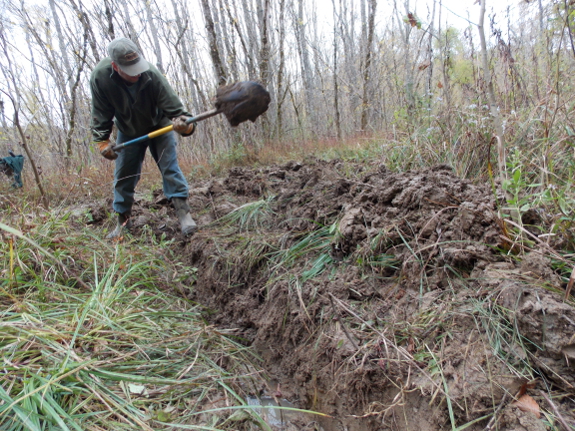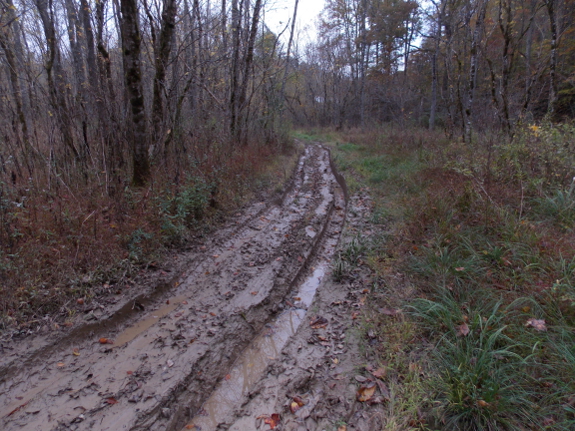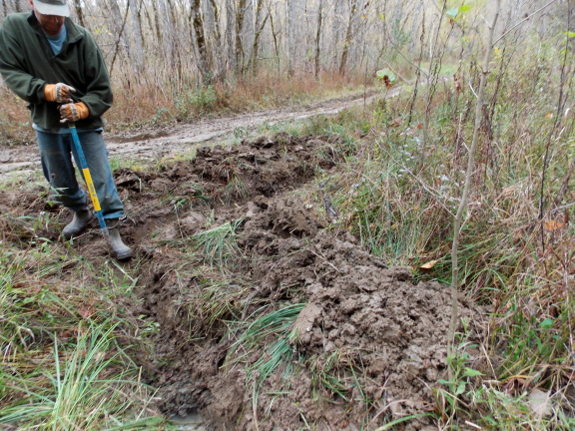
Ditch experiment

I've spent most of
this week with my brain in 2006, reading back over journals from
that era as research for my
upcoming ebook.
One thing that's struck me is how much rock we've thrown into our
driveway, and how little difference there seems to be between 2006
and today.

I'd say that our
driveway is moderately dry at the moment, but it still has lots of
water standing in the ruts...and lots of ruts. Part of the
problem is that we focus our efforts on those ruts, and we keep
changing vehicles so the orientation of the ruts keeps changing,
but I think part of the issue is also that we're looking at the
problem with the wrong perspective.
Although we'll
probably fill our current ruts with rock as we've done before, I
thought now would be a good time to experiment with
ditching. My sky
pond project
gave me an inkling of how moving water around can dry up certain
areas, so Mark and I went down to the worst spot (pictured above)
and dug a little ditch parallel to the curve on the downhill side
(sloping into the center of the curve), then another ditch
perpendicular to that running further downhill toward the creek
(and sloping downhill).

The ditches were
already filling up with groundwater as we dug. In a few days
--- barring rain --- I should be able to see results. Is the
part of the driveway uphill from this ditched zone drier than the
neighboring driveway area? If so, it'll probably be worth
putting in more time this winter on digging ditches since it
doesn't take all that long (although the effort is pretty intense
cutting through the sedges and rushes).
As a side note, does
anyone have tips on what to do with the ditch dirt? I have a
feeling there's a reason to mound it up on one side or the other
of the ditch, but couldn't seem to work that through, so located
it a bit randomly.
Want more in-depth information? Browse through our books.
Or explore more posts by date or by subject.
About us: Anna Hess and Mark Hamilton spent over a decade living self-sufficiently in the mountains of Virginia before moving north to start over from scratch in the foothills of Ohio. They've experimented with permaculture, no-till gardening, trailersteading, home-based microbusinesses and much more, writing about their adventures in both blogs and books.
Want to be notified when new comments are posted on this page? Click on the RSS button after you add a comment to subscribe to the comment feed, or simply check the box beside "email replies to me" while writing your comment.

Ditches will help, but only to a point. Is the roadbed native soil? If yes, then throw your ditch material in the ruts. Can't get much worse.
You could try throwing small branches, straw, or other fibrous/woody plants down and driving over them until they stick into the mud. But I don't know the long term effects of that. It would probably firm it up quite a bit though. Like an adobe brick.
If it wouldn't wash away in floods, I'd say crushed rock and gravel to raise it up a foot or more and stabilize it. You would still have to grade it and add gravel occasionally. Do you have a source of gravel on your property? You could lay large tree trunks along the side to contain the gravel better.
The ideal would be an engineered road, crushed rock, gravel, and concrete. It wouldn't have to be too thick if you kept heavy trucks off it. I have heard of some people pouring strips of concrete, but I think without a proper roadbed they would settle funny and make it worse.
I received a publication from my local cooperative extension agent - http://extension.oregonstate.edu/catalog/abstract.php?seriesno=PNW+641 [Managing Woodland Roads: a field guide.] It is excellent and has color photos. There is also a road specialist in the local watershed management council. I'm not sure what types of resources you might have available in your area: http://www.dcr.virginia.gov/recreational_planning/documents/vopchapt07g.pdf. But in our area we can get at a minimum a free consultation and walk through with experienced expert. They sometimes have cost share grants available for larger scale restoration/maintenance projects, but often just a consultation can provide quite a few great ideas for the owner's own implementation.
Roads are an often overlooked challenge in property and homesteading management!
Comment #3 is the answer.
Water travels with the least resistance. Build deep ditches on both sides least a foot or more. Plus raise your driveway higher than the ditches. Water will run off the drive into the ditch. You can mix the ditch dirt for the drive with rocks, gravel and such. It will stay dry.
An extra plus if you love crawfish!!!!!!
Perfect cool weather for hard labor.
Edith
I hope it's understood that the ditches on both sides need to be parallel to the road. You will need a Tractor with a front loader to get it done correctly.
Edith
Use the material from the ditches to fill up the ruts and make the road surface higher that the surrounding area, so that water runs off the road. For the same reason, road surfaces are usually concave.
Some quotes:
And:
You'll need a significant amount of fill material to fix the road surface:
Why not make mini garden beds next to your ditches, you can plant your perennials and watch them regrow each year. As far as the ditches go, why not try filling in the ruts with the flat cinder blocks they sell at lowes. I don't know what they are called. But fill in the ruts with them then add gravel or dirt to keep them in place. Just an idea from someone who knows nothing about rut filling. I am still loving your blogs, thank you for posting.
Looks like the road surface is a clay-heavy muddy mess.
I like the suggestions above to add the extra material to the driveway, but if it's all the same soft stuff that may not help too much. I DO recall that there are lower areas in the garden that could benefit from some added height to stay drier, no doubt this material would be just as useful there?
I've read that sand often gathers at slow spots in rivers, is there a place on or near your property where you can pull sand right out of the river? If so, I would add that to the surface of the driveway (especially when doing rut repair). Just as in making cob the sand will act as a binder and aggregate for the muddy clay and should improve the surface while use improves compaction and continues to work the sand into the material.
If you can't get sand then gravel, pea stone, wood chips and the like would help with this also, if not as much. As a last resort, using small logs or larger mill waste slabs (I forget what they call the rough bits with the bark on them now) to "pave" the worst sections would provide a clean (if bumpy) solution in addition to the ditch and diversion.
If the water is not allowed to drain off somewhere then nothing will work. You can add material until hell freezes over but it will still be muddy and eventually it will all sink thus you are back where you started.
You must raise the drive, and allow for drainage.
Edith